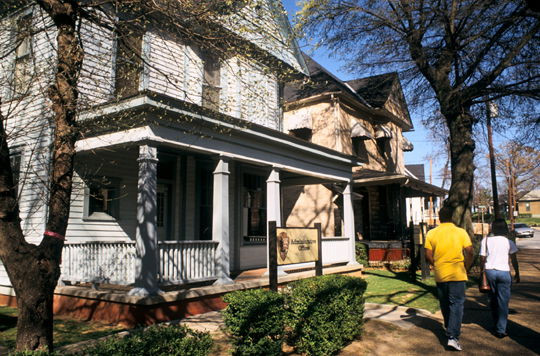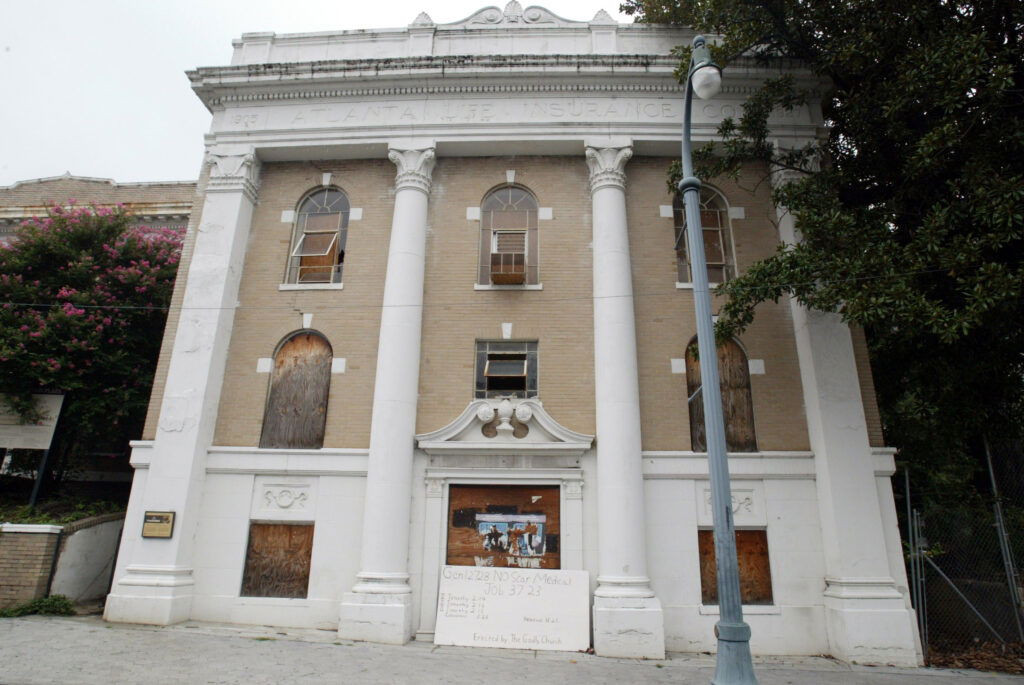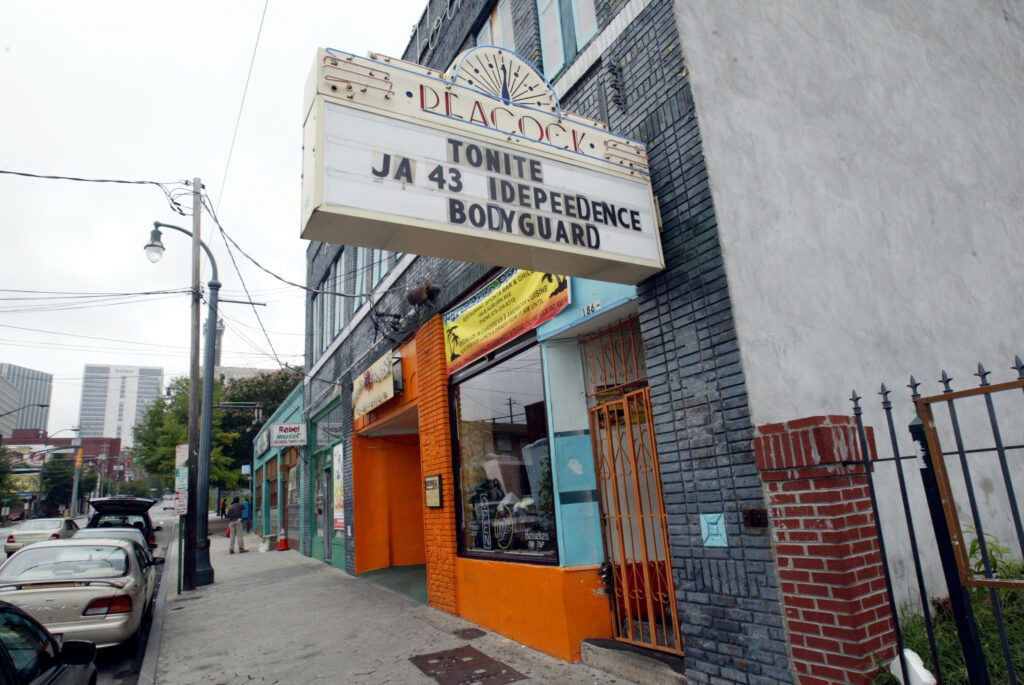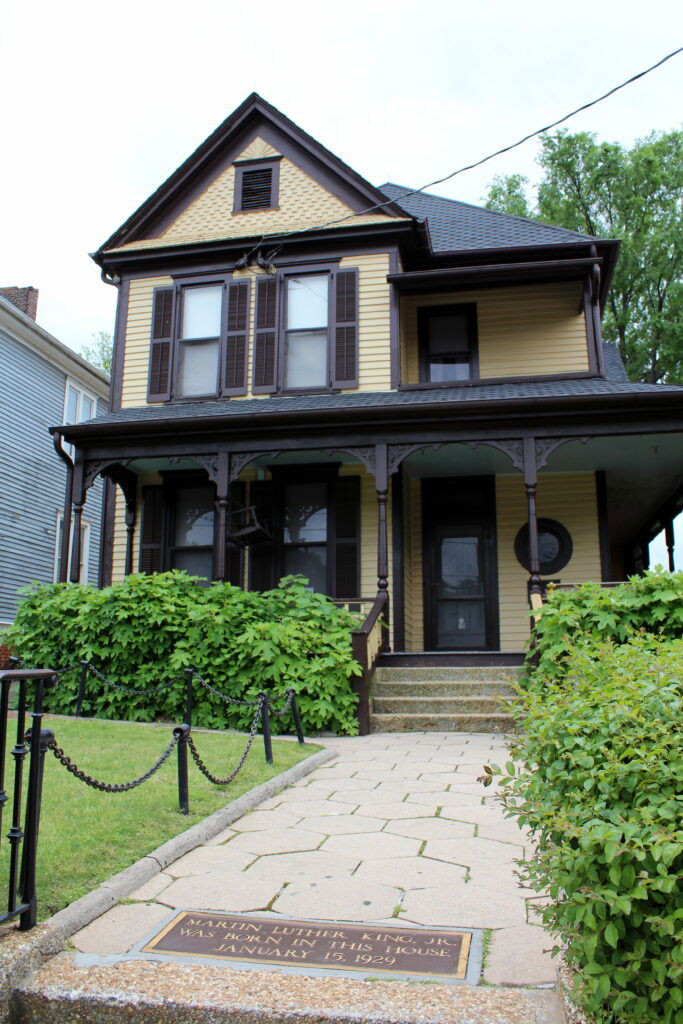Extending just under two miles eastward from the bustling Peachtree Street, Auburn Street stood as the vibrant commercial, cultural, and spiritual epicenter of African American life in Atlanta, Georgia, before the transformative Civil Rights Movement. This iconic street, often lovingly referred to as “Sweet Auburn,” was renowned throughout the South for its unparalleled concentration of Black-owned businesses, lively entertainment venues, and influential churches. The street’s dynamic retail scene and the affluence of its Black business proprietors garnered national recognition, solidifying Auburn Street’s reputation as a hub of African American finance and entrepreneurial spirit. In a memorable 1956 article, Fortune magazine famously hailed Auburn Street as “the richest Negro street in the world,” a testament to its remarkable economic and cultural significance.
 Sweet Auburn Historic District
Sweet Auburn Historic District
The Golden Age of Auburn Street
Originally named Wheat Street, the thoroughfare underwent a name change in 1893, becoming Auburn Street at the behest of white residents who felt “Auburn Avenue” possessed a more sophisticated and cosmopolitan appeal. Over the subsequent two decades, as the oppressive Jim Crow legislation became deeply entrenched in law, Atlanta’s African American population found themselves increasingly confined to specific areas. These areas included the district between downtown Atlanta and Atlanta University, as well as neighborhoods on the city’s east side, now recognized as the historic Old Fourth Ward. It was during this era of segregation and resilience that Auburn Street began its ascent to prominence as a thriving commercial artery and became the residential and business address of the burgeoning Black middle class in Atlanta.
While Auburn Street was predominantly characterized by small businesses, it also became the home of what historian Gary Pomerantz aptly describes as Atlanta’s “three-legged stool of Black finance.” The first of these pillars was established by Alonzo Herndon, a formerly enslaved man who rose to become Atlanta’s first Black millionaire. After building a considerable fortune as the owner of a barbershop on Peachtree Street, Herndon founded the Atlanta Life Insurance Company in 1905. Adding to this financial landscape, Heman Perry, an ambitious entrepreneur from Texas, established the second Black insurance company, Standard Life, six years later. Citizens Trust Bank completed the powerful trio, forming the third leg of this Black financial stool. This institution played a crucial role by extending credit to Black homeowners and business owners who were often denied services by white-owned lending institutions in the city. Auburn Street’s concentration of financial power, representing a unique consolidation of African American wealth for its time, led Black Atlantans to affectionately dub the street “Sweet Auburn.” This endearing name, coined by John Wesley Dobbs, a respected civic leader and the neighborhood’s unofficial “mayor,” eloquently captured Auburn Street’s esteemed status as a national nucleus of Black commerce and community.
 Atlanta Life Insurance Building on Auburn Street
Atlanta Life Insurance Building on Auburn Street
Beyond its significant commercial activity, Auburn Street was the vibrant heart of Black Atlantan social and spiritual life. Residents gathered to worship at Auburn Street’s numerous churches, most notably Ebenezer Baptist Church, where three generations of Martin Luther King Jr.’s family served as pastors, and Big Bethel African Methodist Episcopal Church. For dining and socializing, there was the legendary Ma Sutton’s restaurant, and for late-night entertainment, the famous Top Hat Club, later known as the Royal Peacock, pulsed with the rhythms of ragtime and jazz. The street was also a vital hub for civil rights and social justice organizations. The National Association for the Advancement of Colored People (NAACP), along with groups like the Odd Fellows, the Masons, and the National Urban League, maintained offices on Auburn Street. Further cementing its importance, Auburn Street was home to the Atlanta Daily World, the nation’s first successful Black-owned daily newspaper. Whether for professional endeavors, spiritual nourishment, or leisure and entertainment, Auburn Street was unequivocally the dynamic center of African American life in Atlanta.
 Royal Peacock Club on Auburn Avenue
Royal Peacock Club on Auburn Avenue
Civil Rights Era and Beyond: Transformation and Challenges
Ironically, Auburn Street’s deep-rooted civic activism played a role in its subsequent decline. As organizations like the NAACP and local voting-rights groups, operating from their Auburn Street offices, persistently lobbied state and local governments to dismantle segregation, and as Martin Luther King Jr., a native son born at 501 Auburn Street, spearheaded the national crusade for civil rights, the street began a period of significant decline. With the hard-won removal of legal barriers to integration, many Auburn Street business owners chose to relocate their enterprises to other, newly accessible areas of the city. Simultaneously, residents began migrating to Atlanta’s west side, seeking new opportunities and integrated communities. Adding to these challenges, the construction of the Downtown Connector, a major highway, physically bisected Auburn Street, further disrupting the community’s fabric. Once a thriving and dynamic hub, Sweet Auburn began to suffer from disinvestment and neglect, its vibrant community slowly unraveling. As Gary Pomerantz poignantly observed, Auburn Street “turned into a decaying memorial to a bygone era,” a somber yet necessary consequence of the struggle and eventual gains of the freedom movement.
 Martin Luther King Jr. Birth Home on Auburn Avenue
Martin Luther King Jr. Birth Home on Auburn Avenue
Despite numerous and dedicated efforts at urban renewal, Auburn Street continues to grapple with the effects of urban blight. A revitalization initiative launched by Atlanta Mayor Maynard Jackson in the 1970s, while well-intentioned, did not succeed in reversing the neighborhood’s downward trajectory. Subsequent administrations have also struggled to maintain a consistent and impactful commitment to the neighborhood’s revitalization. Auburn Street’s designation as a National Historic Landmark in 1976, followed by the establishment of the Martin Luther King Jr. Center for Nonviolent Social Change and the Martin Luther King Jr. National Historic Site in the 1980s, initially sparked hopes for a neighborhood resurgence. However, these expectations have largely remained unfulfilled. While these landmark sites are major tourist attractions in Atlanta, drawing over 600,000 visitors annually (as of 2005), very few of these visitors venture beyond the immediate vicinity to explore dining or entertainment options further down Auburn Street.
Undeterred by past setbacks, residents and passionate advocates remain committed to the revitalization of Sweet Auburn. In 1984, civil rights leader Hosea Williams founded the Sweet Auburn Heritage Festival, an annual event that brings entertainment, diverse food offerings, art displays, and engaging children’s activities to Auburn Street each year, celebrating its rich cultural legacy. As of 2006, a significant $45 million redevelopment plan, spearheaded by the historic Big Bethel African Methodist Episcopal Church, aimed at creating thousands of square feet of retail space and hundreds of new condominiums, signaled a renewed hope for community revitalization. Furthermore, the area has been designated a “tax allocation district,” which means that potential development projects are eligible for municipal financial support. While the future of Sweet Auburn remains uncertain and faces ongoing challenges, its dedicated supporters firmly believe in its potential to reclaim its former glory as a vital and culturally rich heart of Atlanta.
